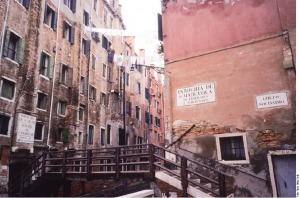VENICE AND THE GHETTO A Cosmopolitan Community
The world’s first ghetto was nothing like the racial enclaves and impoverished neighbourhoods that the use of the term conjures up today.
Nor was it a voluntary refuge where immigrants clustered, preferring their own company to that of the host population.
On the contrary, the Jewish population of Venice was abruptly removed to one of the lagoon city’s 117 islands, Canarregio, and housed there under lock and key in 1516 — 500 years ago this year.
The alternative was to expel them following the wishes of Pope Innocent VIII.
But the canny Venetians, who were never slavish followers of Rome, knew “their Jews” were valuable, particularly as the chief source of financial credit in an age of trade.
Jews acted as moneylenders, a role imposed on them by the church, which used their services but considered it a sinful profession.
Shylock from Shakespeare’s The Merchant of Venice was one such moneylender.
“If you prick us with a pin, don’t we bleed?” he famously asked.
“If you tickle us, don’t we laugh? If you poison us, don’t we die? And if you treat us badly, won’t we try to get revenge?”
Prohibited from all forms of work other than trade and peddling old clothing, Jews made their livelihoods as merchants, but suffered the indignities of life behind walls and a midnight curfew.
When venturing out of the ghetto, Jews were forced to wear particular colours, such as yellow or black, don distinctive headwear such as cone hats, and wear circle badges on the front of their clothing.
They were also forced to pay extra taxes, were not allowed to own land and were expected to pay three times the rent paid by gentiles.
Nonetheless, the Jews of Italy were better off than their brethren in Spain and Portugal, who were expelled at the end of the 15th century.
Those who converted to Christianity and were permitted to stay were regularly brought before the Inquisition, suspected of being “secret Jews”, and burned at the stake.
To escape the Inquisition, many Jews from Spain and Portugal fled to the Venetian ghetto, which swelled. By the 17th century the population had reached about 5,000.
Each language group — German Jews, Spanish Jews, Italian Jews and the Jews from the Levant — had its own synagogues, where they spoke their own language and followed their own distinctive customs.
To accommodate the growing numbers, the ghetto expanded, largely upward, with apartment buildings reaching up to nine floors high. Windows facing out of the ghetto were not allowed.
Freedom finally came to the Jews when Venice fell to Napoleon Bonaparte in 1797. Napoleon abolished the ghetto and its many restrictions. The more prosperous Jews moved out, some of them taking up residence on the Grand Canal.
“Venice was a cosmopolitan city,” said Martina Masarro, the co-curator of a major exhibition at the Ducale Palace making 500 years of Venice’s Jewish history.
“The ghetto became a cosmopolitan ghetto.”
*ABC Australia, 12.11.16

